Sisters and Brothers for Life
Sisters and Brothers for Life
Making Sense of Sibling Relationships in Adulthood
Suzanne Degges-White
Rowman & Littlefield
Lanham Boulder New York London
Published by Rowman & Littlefield
A wholly owned subsidiary of The Rowman & Littlefield Publishing Group, Inc.
4501 Forbes Boulevard, Suite 200, Lanham, Maryland 20706
www.rowman.com
Unit A, Whitacre Mews, 26-34 Stannary Street, London SE11 4AB
Copyright 2017 by Rowman & Littlefield
All rights reserved . No part of this book may be reproduced in any form or by any electronic or mechanical means, including information storage and retrieval systems, without written permission from the publisher, except by a reviewer who may quote passages in a review.
British Library Cataloguing in Publication Information Available
Library of Congress Cataloging-in-Publication Data
Names: Degges-White, Suzanne, author.
Title: Sisters and brothers for life : making sense of sibling relationships in adulthood / Suzanne Degges-White.
Description: Lanham, Maryland : Rowman & Littlefield, [2017] | Includes bibliographical references and index.
Identifiers: LCCN 2016057630 (print) | LCCN 2017022304 (ebook) | ISBN 9781442265950 (electronic) | ISBN 9781442265943 (cloth : alk. paper)
Subjects: LCSH: Brothers and sisters. | Interpersonal relations. | Families.
Classification: LCC BF723.S43 (ebook) | LCC BF723.S43 D44 2017 (print) | DDC 155.44/3dc23
LC record available at https://lccn.loc.gov/2016057630
 The paper used in this publication meets the minimum requirements of American National Standard for Information SciencesPermanence of Paper for Printed Library Materials, ANSI/NISO Z39.48-1992.
The paper used in this publication meets the minimum requirements of American National Standard for Information SciencesPermanence of Paper for Printed Library Materials, ANSI/NISO Z39.48-1992.
Printed in the United States of America
Acknowledgments
Thank you to all of the study participants around the globe who shared their adult sibling relationship stories of triumph, tragedy, and everything in between. Family relationships can be messy, and I appreciate all of the individuals who let me peek inside their family systems.
I offer heartfelt appreciation to my brother, Andrew, who taught me a lot about conflict, resolution, sibling loyalty, and love.
Lastly, I acknowledge the enthusiastic support of my editor, Suzanne Staszak-Silva. Her continued belief in my ideas has been a gift.
Preface
While no one is likely to love you more than your own mother, no one is likely to know you as well as your siblings. Growing up in the same home, sharing mealtimes, playtimes, and disciplinary experiences, you and your siblings became intimately acquainted with one another in a way that is seldom experienced in life. Many people erroneously equate intimacy only with feelings such as love and support. Unfortunately, intimate family relationships are not always the picture of peace and harmony one might hope. Some siblings begin life as the best of friends, grateful for the presence of a companion. Other siblings may argue and fight throughout childhood, only learning how much they appreciate one anothers presence in their lives in adulthood. This book is designed to provide assistance and suggestions to help readers better manage, or even reestablish, their adult sibling relationships.
Organization of the Book
Multiple large-scale research studies have used existing data sets to predict attitudes, behaviors, and experiences of siblings and parents. This current study explores the responses of more than four hundred adults to a set of open-ended questions relating to sibling relationships and their development and transitions in adulthood. The survey questions and demographic data of the online respondents are found in Appendix A. For the purposes of clarity and consistency, pseudonym first names are used throughout the book. These names have been chosen for convenience by the author and are not knowingly the actual names of any of the respondents, as no identifying information was collected in the online survey. Face-to-face interviewees names have also been changed to respect their privacy.
Hundreds of adults shared about their relationships with siblings. Women and men described their relationship conflicts, challenges, turning points, and regrets. People learn about negotiation, compromise, winning, and losing from their siblings. The lessons learned in youth can shape the roles we play in adult relationships as well as the expectations we place on friends and romantic partners. The old saying that the apple doesnt fall far from the tree speaks to the power of parental influence, but siblings are just as genetically similar to one another as they are to either parent. Though temperaments and personalities can differ markedly between siblings, evolution and socialization encourage the desire for an enduring bond with our sibs.
Unfortunately, past interactions can forestall attempts to maintain a warm and supportive sisterly or brotherly bond. The closest there is to a one-size-fits-all magic solution to relationship problems is effective communication. Using real-life examples of sibling battlegrounds or standoffs, suggestions are provided for approaching time bomb topics in such a way that no one is left feeling emotionally assaulted and the relationship isnt sacrificed in the fray.
Siblings in Family Context
The first section of this book is titled Family Constellations, Culture, and Communication. The first chapter explores the role that birth order may play in childhood and into adulthood. The constellation of a family refers to the size and shape of the familynumber and gender of siblings, presence or absence of parents or stepparents, and so on. Family constellations shape our childhood experiences and the choices we make regarding our own nuclear families in adulthood. The next chapter explores the ways in which culture and family heritage can influence sibling relationships. A wide lens is used to capture many forms of diversity, including ethnicity and culture. One event that can permanently alter family constellation and functioning is the death of a child. The third chapter presents a developmentally structured examination of the ways that this loss can influence surviving siblings. In the fourth chapter, we explore communication pattern development between siblings and family members.
Baggage from the Past
The second section of the book is titled The Effects of the Past on the Present, and it includes four chapters that address the earliest appearance of specific family dynamics or sensitive topics that often defy open discussion in families-of-origin. The first chapter focuses on the potential for sibling rivalry to remain active into adulthood. Addressed in the following chapter is the potentially lasting influence of favoritism or family roles, such as the black sheep or the favorite. The next chapter takes aim at potentially painful family secrets such as abuse and addictions. The final chapter focuses on taboo topics such as sex, politics, religion, and money.
Right Here, Right Now
The third section of the book is titled Focus on the Present. In this section, we explore topics that can be difficult for siblingsor even good friendsto discuss. Siblings lifestyle choices and shortcomings are covered as are siblings romantic relationships and caring for siblings facing health and wellness challenges.
Preparing for the Future
The final section, Making Changes for the Future, opens with a chapter that addresses the realities of caring for aging parents and coping with their deaths. The next chapter explores ways to enhance adult sibling communication. The final chapter, Siblings for Life: Closing the Gaps in the Family Circle, addresses the ways in which our sibling relationships affect other adult relationshipsfriendships and romantic partnershipsand ways to bring closure to residual conflicts from the past and build the foundation for positive, long-lasting sibling support.
Next page
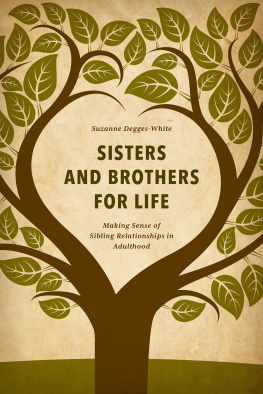


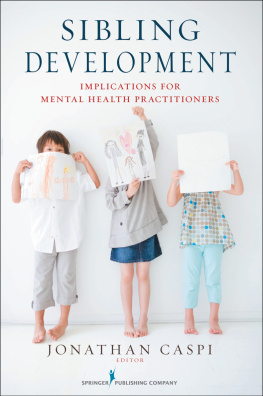
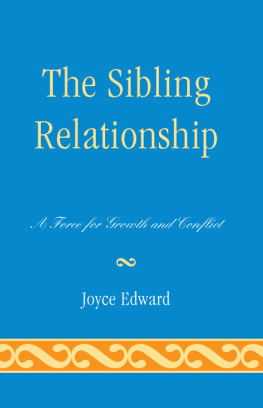


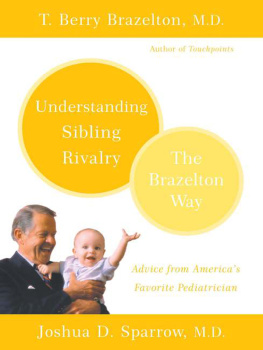
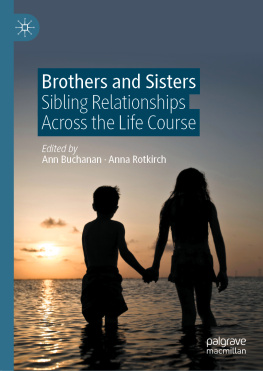
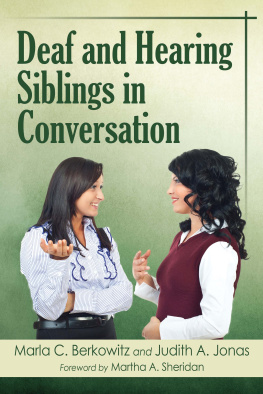
 The paper used in this publication meets the minimum requirements of American National Standard for Information SciencesPermanence of Paper for Printed Library Materials, ANSI/NISO Z39.48-1992.
The paper used in this publication meets the minimum requirements of American National Standard for Information SciencesPermanence of Paper for Printed Library Materials, ANSI/NISO Z39.48-1992.